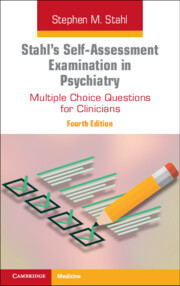Book contents
- Stahl’s Self-Assessment Examination in Psychiatry
- Stahl’s Self-Assessment Examination in Psychiatry
- Copyright page
- Contents
- Introduction/Preface
- CME/CE Information
- 1 ADHD and Its Treatment
- 2 Anxiety/Stress Disorders and Their Treatment
- 3 Basic Neuroscience and Pharmacological Concepts
- 4 Bipolar Disorder and Its Treatment
- 5 Chronic Neuropathic Pain and Its Treatment
- 6 Dementia and Its Treatment
- 7 Psychosis and Its Treatment
- 8 Sleep/Wake Disorders and Their Treatment
- 9 Substance Use/Impulsive-Compulsive Disorders and Their Treatment
- 10 Unipolar Depression and Its Treatment
- Index
- References
3 - Basic Neuroscience and Pharmacological Concepts
Published online by Cambridge University Press: 22 July 2022
- Stahl’s Self-Assessment Examination in Psychiatry
- Stahl’s Self-Assessment Examination in Psychiatry
- Copyright page
- Contents
- Introduction/Preface
- CME/CE Information
- 1 ADHD and Its Treatment
- 2 Anxiety/Stress Disorders and Their Treatment
- 3 Basic Neuroscience and Pharmacological Concepts
- 4 Bipolar Disorder and Its Treatment
- 5 Chronic Neuropathic Pain and Its Treatment
- 6 Dementia and Its Treatment
- 7 Psychosis and Its Treatment
- 8 Sleep/Wake Disorders and Their Treatment
- 9 Substance Use/Impulsive-Compulsive Disorders and Their Treatment
- 10 Unipolar Depression and Its Treatment
- Index
- References
Summary
An excitatory signal is received at the dendrite of a pyramidal glutamate neuron. When the signal is released from the incoming presynaptic dopaminergic axon, it is received as an inhibitory signal. However, this signal is not integrated properly with other incoming signals to that neuron. Which is the most likely site at which the error of integrating this signal with other incoming signals occurred?
- Type
- Chapter
- Information
- Stahl's Self-Assessment Examination in PsychiatryMultiple Choice Questions for Clinicians, pp. 75 - 106Publisher: Cambridge University PressPrint publication year: 2022

